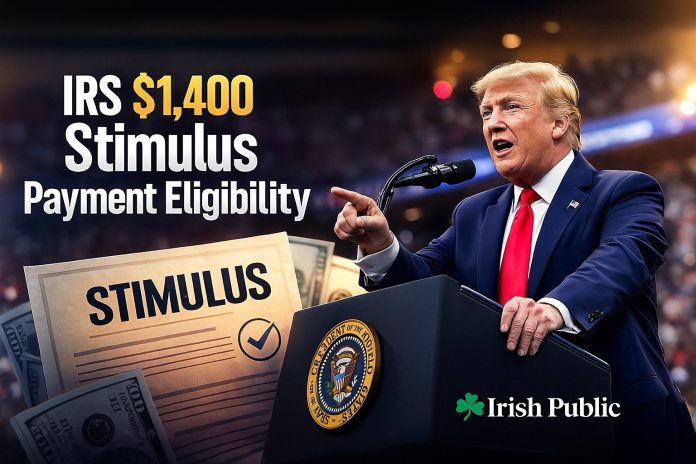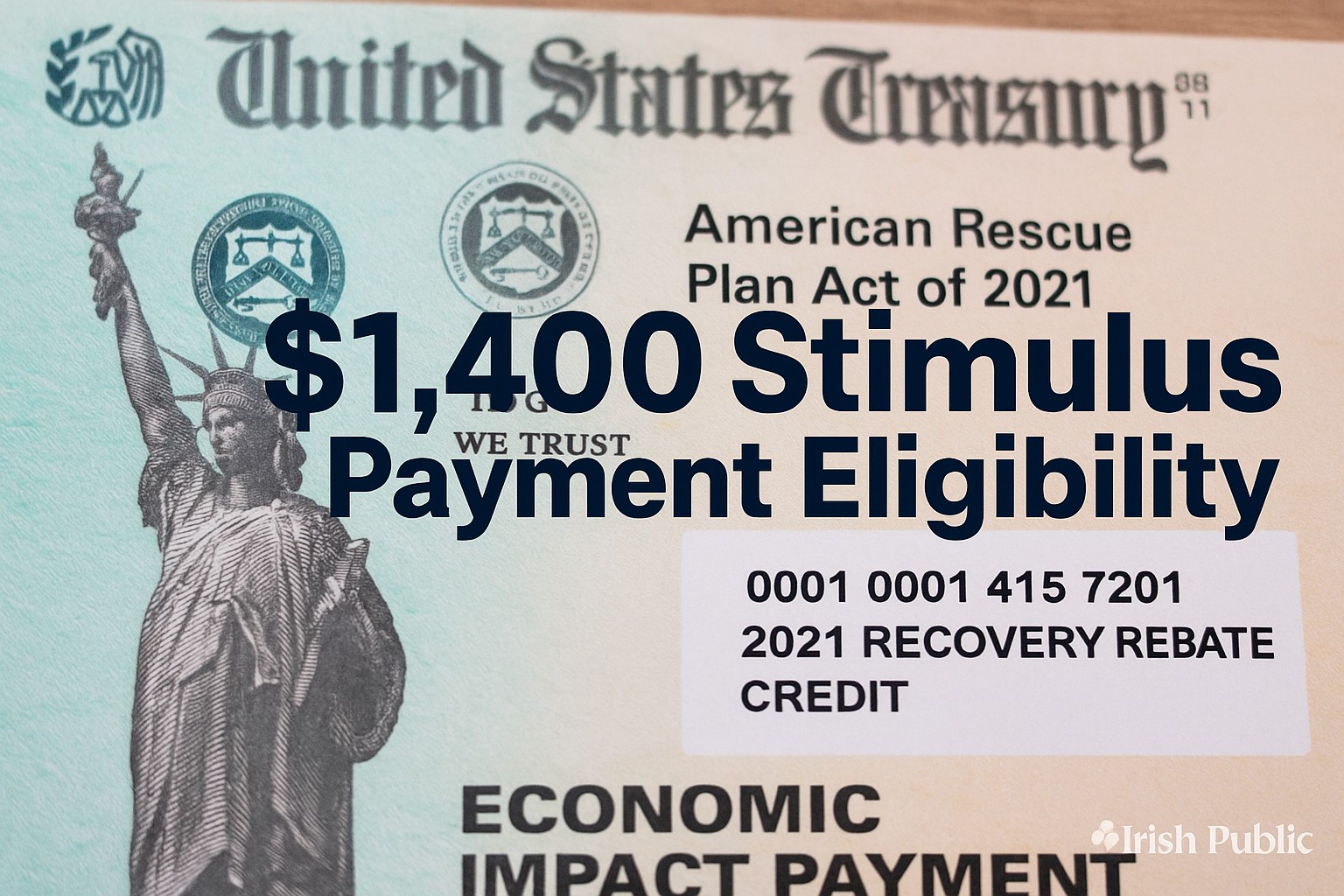You qualified if you had a valid Social Security Number, were a U.S. citizen or resident in 2021, were not a dependent on someone else’s 2021 return, and your income fit the limits.
The full amount was $1,400 per eligible person, plus $1,400 per qualifying dependent. People who missed it used the 2021 Recovery Rebate Credit on the 2021 tax return.
The IRS handled the payment process. Most people received the money directly. Others qualified later and had to file a tax return to get it. Some still do not know if they had a chance to claim it. Many assume the window has closed forever.
This article explains the full picture. You will learn what the payment means, who was eligible, how the process worked, and what to do if you never got it. The language is simple. The facts are clear. You do not need a tax expert to understand this guide.
What the $1,400 Payment Was
The $1,400 payment was the third stimulus check. Congress approved it in 2021 to help people during COVID-19.
The IRS sent money by direct deposit, paper check, or a prepaid card. The payment was not a loan. The IRS did not tax it. It did not reduce any refund.
How to Check Your IRS $1,400 Stimulus Payment Eligibility
You can check your eligibility for the $1,400 stimulus payment through your 2021 tax return and your IRS Online Account.
Step 1: Review Your 2021 Tax Return
Look for the Recovery Rebate Credit on line 30 of Form 1040 or 1040-SR. If you received the full amount, that line may say 0. If you missed the payment or received less, the IRS may have added a credit there.
Step 2: Check IRS Letter 6475
The IRS mailed Letter 6475 to people who got the third stimulus. This letter shows how much you received. If you no longer have the letter, use your IRS account.
Step 3: Log in to Your IRS Online Account
Go to the official IRS site to access your account: payments, your online account.
This account shows:
- Your 2021 payment history
- Any stimulus payments received
- Tax return processing status
- Refund details
Make sure the site address starts with https://www.irs.gov.
Step 4: Compare and Confirm
Compare the amount you received (Letter 6475 or IRS account) with what you qualified for.
Check your filing status, adjusted gross income, and dependents. Use those facts to see if you missed any part of the $1,400 stimulus.
Who Qualified in Simple Terms
You qualified if you met four core rules. You had a valid SSN. Anou were a U.S. citizen or resident alien in 2021.
No one claimed you as a dependent on a 2021 return. Your income stayed within the limits. Your dependents also needed valid ID. The IRS checked all of this on your return.
Income Limits and Phase-Out
The IRS used adjusted gross income. That number sits on your tax return. Lower AGI meant a full payment. Higher AGI reduced it fast.
- Single filers got $1,400 up to $75,000 AGI. Nothing at $80,000.
- Married filing jointly got $2,800 up to $150,000 AGI. Nothing at $160,000.
- Head of household got $1,400 up to $112,500 AGI. Nothing at $120,000.
Each qualifying dependent added $1,400 to the total. Phase-out still applied to the household.
Quick example: A couple with $148,000 AGI and one child met the limit. They got $2,800 + $1,400 = $4,200.
Dependents and Family Size
Dependents raised the total payment. The IRS counted children and other qualified dependents who met age and support rules.
Each one added $1,400. The filer received the money, not the dependent. Both returns must match the same family facts. Two people cannot claim the same dependent.
Example: A head of household with two children and $108,000 AGI got $1,400 × 3 = $4,200.
People Who Often Qualified
Many seniors qualified. Social Security, SSI, SSDI, and VA benefits did not block the payment. Many veterans qualified.
Workers with low or moderate income qualified. Parents with newborns in 2021 qualified once they listed the baby on the 2021 return. Students qualified if no one claimed them.
People Who Did Not Qualify
Nonresident aliens did not qualify. People claimed as dependents did not qualify on their own.
People without valid SSNs did not qualify, except in narrow cases set by law. High-income filers above the phase-out caps did not qualify. Estates and trusts did not qualify.
How People Who Missed it Claimed the Money
People who never got the full amount used the 2021 Recovery Rebate Credit. That credit appeared on the 2021 Form 1040 or 1040-SR.
The rules matched the third stimulus rules. IRS Letter 6475 showed what the IRS had already sent. The credit filled the gap and flowed into the refund.
Example: A parent had a baby in July 2021. No payment came for the baby during the rollout. The parent listed the baby on the 2021 return. The credit added $1,400 to the refund.
Common Mistakes that Cut the Amount
Many people lost money due to small errors. Some never filed a 2021 return. Some typed a wrong SSN. And some left off a newborn or adopted child.
Some marked zero on the credit line by mistake. Some used an old bank account. Mail went to an old address in other cases. Each error slowed or blocked the payment.
Fix tip: Check your 2021 return and Letter 6475. If the numbers do not match, file an amended return with Form 1040-X.
Students and Young Adults
A student could get the payment only if no one claimed them as a dependent. Many families decided who would claim the student before filing.
That choice set the result. A student who paid most living costs and filed alone often qualified. A student claimed by a parent did not receive a separate check.
Example: A 20-year-old student lived off campus, paid rent, and filed a return. Parents did not claim the student. The student qualified if income fit the limits.
Seniors and Fixed Income
Seniors on Social Security or SSI often qualified. The IRS used direct deposit in many cases.
Some seniors still needed the credit on the 2021 return to catch a shortfall. AARP Tax-Aide and VITA sites gave free help with returns.
Mixed-Status Households
Some households included one spouse with a valid SSN and one spouse without one. The law allowed part of the payment in some cases.
The details depended on the return and the IDs for each person. Clean records and exact names reduced delay.
Records you Should Keep
Keep your 2021 tax return. Keep any amended return. And keep Letter 6475. Keep SSN cards, birth records, and adoption papers. Keep bank statements that show any deposit. Good records settle questions fast.
Scam Safety
Scammers targeted people who expected a check. The IRS did not call to demand cash. The IRS did not ask for gift cards.
Fake emails and fake texts sent people to fake sites. Type IRS.gov yourself into the browser. Do not click random links. Protect your SSN and bank account.
More Examples to Make it Clear
- Single filer, $44,000 AGI, no kids: Full $1,400.
- Single filer, $82,000 AGI: No payment.
- Married couple, $151,000 AGI, two kids: Small or no payment due to fast phase-out.
- Head of household, $100,000 AGI, one child: Full $2,800.
- Parent with baby born in December 2021: Add the baby on the 2021 return. Claim $1,400 through the credit.
Simple Checklist to Review your Case
Check your AGI on the 2021 return. Confirm your filing status. Confirm each dependent and SSN. Read Letter 6475.
Compare the amount you got with the amount you should have received. Fix gaps with an amended return if rules still allow it.
Helpful Ways to Avoid Problems Next Time
Update your address with the IRS after any move. Update your bank data with your return. Match names exactly to Social Security cards.
Keep a folder with ID, birth records, and IRS letters. Use trusted software or a trusted preparer. Review each line before you file.
Conclusion
The $1,400 payment gave real help during a hard year. Simple rules set who qualified and how much they received. Income, filing status, valid SSNs, and dependents drove the result.
People who missed it had one path through the 2021 Recovery Rebate Credit. Clean records and careful entries made that path smooth. Keep your documents safe. Stay alert to scams. Good prep makes future relief easier and faster.
People Asked FAQs
Who is eligible for the $1,400 stimulus check?
People who, in 2021, had a valid SSN, were U.S. citizens or resident aliens, were not claimed as someone else’s dependent, and met the income limits: up to $75,000 (single), $150,000 (married joint), or $112,500 (head of household). Each qualifying dependent added $1,400.
How do I know if I’m getting a stimulus check?
The IRS finished sending the third checks. To see if you should have received it, check your 2021 tax return for the 2021 Recovery Rebate Credit and review IRS Letter 6475 or your IRS Online Account. The old “Get My Payment” tool is no longer active.
Who qualifies for the “new” stimulus check?
There is no new check. Recent payments were the IRS catching up on unclaimed 2021 Recovery Rebate Credit for people who met the same 2021 rules. The claim window tied to the 2021 filing closed on April 15, 2025.
Are we going to get a fourth stimulus check?
As of now, there are no new federal stimulus checks planned. Reports about fresh checks in 2025 are false or refer to other programs.


